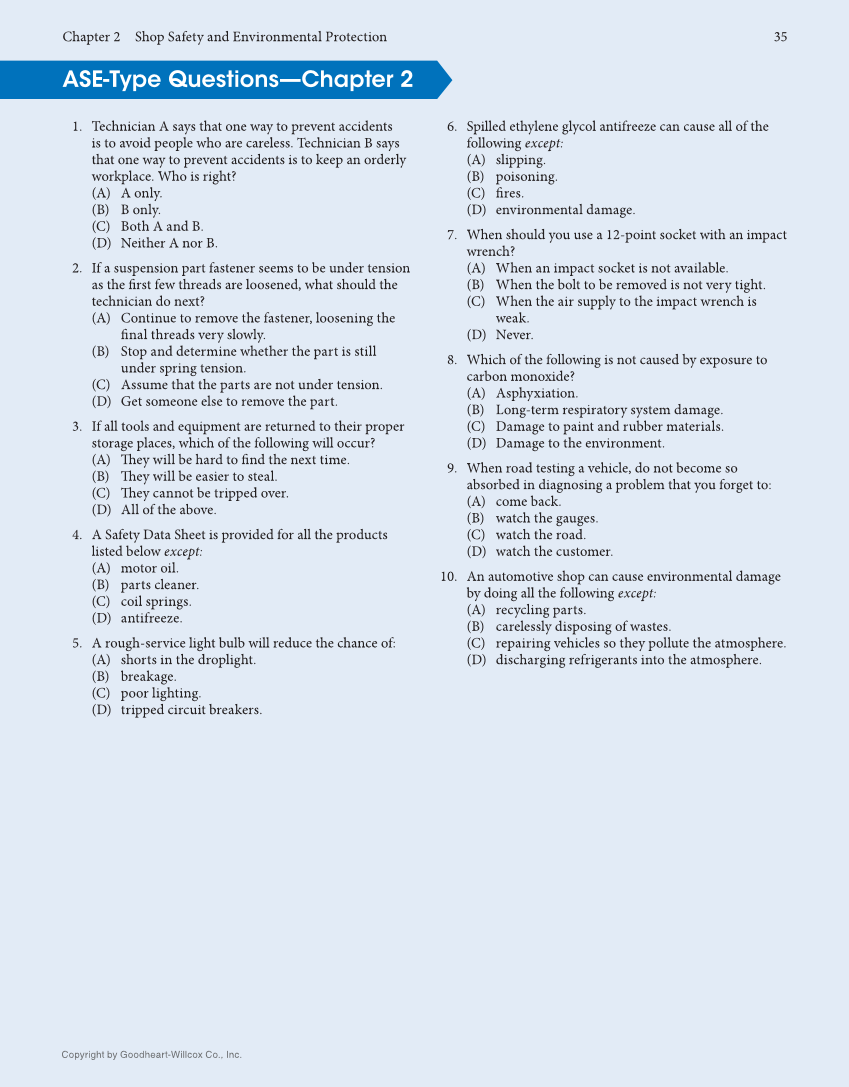Chapter 2 Shop Safety and Environmental Protection 35 Copyright by Goodheart-Willcox Co., Inc. 1. Technician A says that one way to prevent accidents is to avoid people who are careless. Technician B says that one way to prevent accidents is to keep an orderly workplace. Who is right? (A) A only. (B) B only. (C) Both A and B. (D) Neither A nor B. 2. If a suspension part fastener seems to be under tension as the fi rst few threads are loosened, what should the technician do next? (A) Continue to remove the fastener, loosening the fi nal threads very slowly. (B) Stop and determine whether the part is still under spring tension. (C) Assume that the parts are not under tension. (D) Get someone else to remove the part. 3. If all tools and equipment are returned to their proper storage places, which of the following will occur? (A) Th ey will be hard to fi nd the next time. (B) Th ey will be easier to steal. (C) Th ey cannot be tripped over. (D) All of the above. 4. A Safety Data Sheet is provided for all the products listed below except: (A) motor oil. (B) parts cleaner. (C) coil springs. (D) antifreeze. 5. A rough-service light bulb will reduce the chance of: (A) shorts in the droplight. (B) breakage. (C) poor lighting. (D) tripped circuit breakers. 6. Spilled ethylene glycol antifreeze can cause all of the following except: (A) slipping. (B) poisoning. (C) fi res. (D) environmental damage. 7. When should you use a 12-point socket with an impact wrench? (A) When an impact socket is not available. (B) When the bolt to be removed is not very tight. (C) When the air supply to the impact wrench is weak. (D) Never. 8. Which of the following is not caused by exposure to carbon monoxide? (A) Asphyxiation. (B) Long-term respiratory system damage. (C) Damage to paint and rubber materials. (D) Damage to the environment. 9. When road testing a vehicle, do not become so absorbed in diagnosing a problem that you forget to: (A) come back. (B) watch the gauges. (C) watch the road. (D) watch the customer. 10. An automotive shop can cause environmental damage by doing all the following except: (A) recycling parts. (B) carelessly disposing of wastes. (C) repairing vehicles so they pollute the atmosphere. (D) discharging refrigerants into the atmosphere. ASE-Type Questions—Chapter 2
